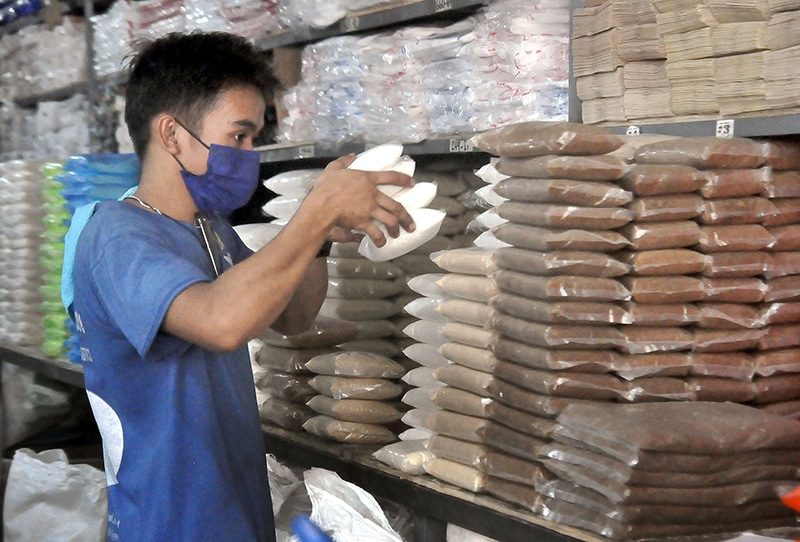Around 350,000 sacks of sugar, most of them imported were found in three warehouses in Silang, Cavite, as the government continues its crackdown against possible sugar hoarding, the Department of Trade and Industry (DTI) said Friday.
Authorities also discovered 36,000 bags of local sugar, DTI Undersecretary Ruth Castelo said.
This developed as the Sugar Regulatory Administration (SRA) is pushing for the restoration of the P2-billion fund for the implementation of the Sugar Industry Development Act (SIDA).
Speaking at the Philippine Sugar Technologists Association’s 68th Annual National Convention at the SMX Convention Center in Bacolod City on Thursday, acting SRA Administrator David John Thaddeus Alba said the SIDA fund was further reduced to only P500 million this year, as the industry has been accused of underutilizing the allocation.
“With proper programming and with the support of President (Ferdinand) Marcos Jr. and our allies in both Houses of Congress, we will ask help to circumvent the red tape and go full blast in utilizing the SIDA fund by next year to make us globally competitive,” Alba said.
Last week, the Bureau of Customs (BOC) found some 44,000 sacks of suspected smuggled sugar, with an estimated value of P220 million, in warehouses in Pampanga and Bulacan.
In a separate operation that week, the BOC said it seized 140,000 bags of white refined sugar with a total tax payment valued at P45.6 million at the Port of Subic.
As a result of that operation, Press Secretary Trixie Cruz-Angeles said six Customs officials were sacked pending the results of the investigation regarding the possibility of conniving with illegal sugar smugglers.
Malacañang earlier said it was looking into the possibility of an “artificial” sugar shortage in the country given recent findings in warehouse inspections.
According to the Palace, inspections have been conducted in sugar warehouses located in the following areas: Deparo, Caloocan City; Balut, Tondo; San Nicolas, Manila; Rosales, Pangasinan; San Fernando, Pampanga; Ibaan, Batangas; and Davao.
The SRA’s Alba, who hails from Negros Occidental, the country’s top producing province, noted that the country’s sugar requirement is around 2.5 million metric tons (MT), which has already been done before, particularly in the crop year 2016-2017 when the industry overshoot that target.
He said, however, that production has been falling short in the past few years because of various factors such as climate change, high inputs prices, and the coronavirus disease 2019 pandemic that drove up production costs.
“But your SRA Board believes that 2.5 million MT is achievable if we focus on farm productivity and ensure the efficiency of our mills for higher recovery,” Alba said.
Doable remedies include implementing a good farm drainage plan and longer planting season, and maximizing resources to invest in research and development, technology, and mechanization, he added.
“This is also why we will work on ensuring that we get the full funding allotted for the implementation of the SIDA so we can efficiently utilize it to meet the industry’s needs,” the SRA chief said.
Alba said one of the proposals of the SRA is “how to get that P2 billion back to be spent for the sugar industry”.
“Not for this year, as the (national) budget has been done. We have to work that out for the next,” he added.
Negros Occidental Fifth District Rep. Emilio Bernardino Yulo, a former SRA board member, said there is a high utilization rate for farm-to-mill roads, which has a 50 percent original allocation or P1 billion under the SIDA.
“What I’m proposing is to allow a corresponding increase to such percentage utilized. We do have problems with the other components. Socialized credit, has a low utilization rate. The problem of SRA is the stringent bureaucratic requirements of the Land Bank of the Philippines,” he added.
Enacted in 2015, the SIDA or Republic Act 10659 aims to promote the competitiveness of the sugarcane industry and maximize the utilization of sugarcane resources, and improve the incomes of farmers and farm workers, through improved productivity, product diversification, job generation, and increased efficiency of sugar mills.
Of the P2 billion annual fund, P1 billion is allocated for infrastructure, mainly for farm-to-mill roads; P300 million for credit; P100 million for scholarships; P300 million for block farm of the land reform beneficiaries; and P300 million for shared facilities program.





